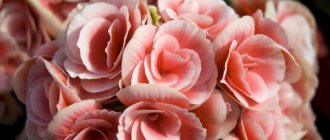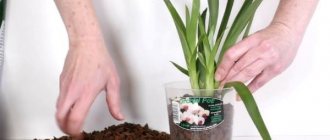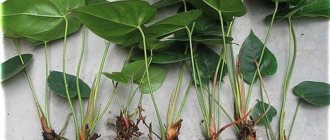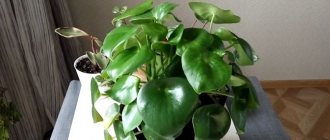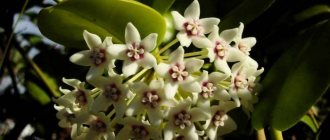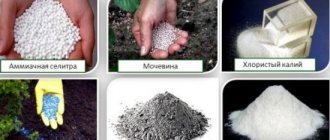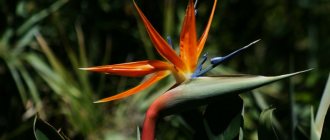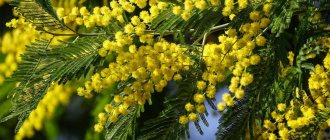All scale insects and false scale insects cause enormous damage to plants. The signs accompanying them are characteristic of all types of scale insects. At the site where the scale insect is sucked, yellow spots appear on the leaves, which grow in size as the juice is sucked out, then the leaf turns completely yellow, curls and falls off. The plant stops growing, the branches become bare, then the entire bush begins to dry out and the plant dies. In addition to leaves, the scale insect damages the fruits of tangerines, lemons and oranges.
Brown scale insect (Chrysomphalus dictyospermi). © fturmo
Scale insects - description
Scale insects , Latin name – Diaspididae. A family of hemiptera insects from the superfamily of scale insects. There are over 2400 species in the family. The body is covered on top with a waxy shield (hence the name of the insect).
All scale insects are distinguished by the fact that they have protective shields and look like plaques on the plant. The mouthparts of all scale insects are sucking. They differ only in size and color. The scale insect is especially dangerous because just a few hours after hatching from the eggs, the larvae are already settling throughout the plant and immediately begin to suck all the juices out of it, and the leaf surface is completely covered with scutes.
The brown scale insect (Chrysomphalus dictyospermi) damages mainly leaves, settling on their upper side. The scutellum of the adult female is round, about 2 mm in diameter, reddish-brown or dark brown. The male's scutum is smaller and oblong in shape.
First aid supplies
First aid means: Seedlings and young trees infected with scale insects are sprayed with a soap solution.
Dissolve tar and laundry soap. You will need a piece of soap for a bucket of water. Go over the needles with a brush. The procedure must be repeated every 7 days. It is also recommended to remove the top layer of soil around the tree, or treat it with hot water with the addition of wood ash. Aktara can be applied to the ground once a month for control and prevention, or watered with Confidor.
- Laundry soap is diluted in water and chopped garlic is added. Let it brew for about an hour. Spray trees - bark, needles. The next day, wash off with a stream of water. It is recommended to repeat the procedure every 3 days until the cultures are completely cured.
- Chop 4 medium onions, add 1 liter of water. Leave for 2 hours. Strain and spray the trees.
- Add red hot pepper to the water and leave for 24 hours. Dilute green soap and carry out the spraying procedure.
- Add wood ash to boiled water, stir, let it brew. The solution is sprayed on needles, tree bark, and watered on the soil.
- Pour celandine with cold liquid and let it brew for a day. Strain and spray the trees.
The fight with folk remedies involves several treatments during the first two weeks.
False shields - description
False scale insects differ from true scale insects in that they do not have a waxy shell, and the eggs and larvae are protected by the drying skin of the dying female.
False scale (Coccidae). © James Clay
False scale insects , or coccids (Coccidae) are a family of hemiptera insects from the superfamily of scale insects. Over 1,100 species have been described, of which about 150 species are found in Europe.
Professional preparations
Chemical preparations for pest control Spruce scale insects are parasitic in the warm season. Already in early spring it is necessary to take care of reliable protection of trees.
- Actellik. Based on a broad-spectrum insecticide. One treatment is enough to keep insects away all summer. Not addictive. The disadvantage is an unpleasant smell.
- Aktara. A universal remedy for harmful insects. But it is recommended to apply in early spring, before the trees bloom. Deadly to bees.
- Bitoxibacillin. Biological drug. It acts more slowly, but can be used at any time during the plant growing season. It is recommended to process every 2 weeks.
False scale insects parasitize many crops: currants, grapes, lemons, plums. Damages the leaf, dark spots form at the site of the lesion. If there is a constant infection of spruce trees, it is necessary to examine the trees growing nearby. It’s not just conifers that will have to be processed.
Reproduction of scale insects and false scale insects
Most species of scale insects reproduce by laying eggs, but there are also viviparous species. Pests live on the underside and top of leaves, shoots and trunks of plants. Only young larvae settle, sticking to various parts of the plant; adult insects are not mobile.
With severe infection, the leaves along the veins and plant trunks become covered with a coating formed from a large accumulation of scale insects. Damaged plants have stunted growth and development, leaves turn yellow and fall off prematurely.
Scale insects and false scale insects secrete a sticky liquid - honeydew, on which a sooty fungus settles, which further impairs the development of plants.
Scale insects and false scale insects damage many indoor plants: palm trees, citrus fruits, oleander, ivy, cyperus, asparagus, aucuba and others.
Adults and larvae function all year round, sucking cell sap from the plant. Damaged plants turn yellow, develop incorrectly, leaves often fall off, and young shoots dry out.
Scale insects belong to fast-growing pests. Reproduction can be either asexual or conventional. It occurs by laying eggs under the scutellum, and some species are viviparous. After hatching, the scale insect goes through several stages of development. At the initial stage, scale insects are very mobile and can quickly spread, in particular to neighboring plants.
Females are immobile, but males can even fly during their lives. However, the life cycle of the male is very short. They live only a few days, unlike females, who live for several months.
Under good conditions, more females are born; under bad conditions, more males are born. The composition of the population changes itself in such a way as to improve its mobility and move to a more favorable place for life.
Ficus leaf infected with false scale insects. © Karl Magnacca
Kinds
The family of pseudoscale insects is diverse: biologists have described more than 1,100 species inhabiting almost the entire planet, with the exception of regions with extremely cold climatic conditions. Of these, 150 are distributed in Europe. In the countries of the former USSR, 4 of them cause the greatest damage to wild and cultivated plants.
Acacia false scale
The acacia false shield, despite its name, is polyphagous. Its “specialization” is mainly fruit bushes (quince, gooseberries, raspberries, etc.) and trees (apricot, pear, cherry, plum). Sometimes the insect lives on walnut and pistachio trees. It is a dangerous pest of valuable wood species, in particular white acacia.
A small insect up to 65 mm long and 4 mm high
The body of the female is predominantly oval, less often round; has no segmentation and is a solid convexity of brown shades. There are numerous dots on its sides. Males are flying insects about 1.5 mm in length, possessing one pair of wings. The proportion of males in the population is very small.
Active years occur in the first ten days of May. By the beginning of summer, females lay eggs under their own body, protecting future offspring from unfavorable environmental conditions. One individual can lay from 1000 to 3000 pieces. The larvae emerging from them bite into the plant, feeding on the juice of the victim. They spend the winter on the trunk and branches of the host, and in the spring, with the beginning of sap flow, they move to young shoots and do not move anymore. After molting, the transformation into an imago occurs.
Spruce moth
The round carapace of the spruce moth is colored chestnut or brown. Its diameter is only 3–6 mm. Flying males measuring 1 mm are not very common. Females lay red eggs under their shell, from which pinkish larvae emerge.
Young larvae immediately attack the tree in search of nutritious sap, climbing between the bud scales. Those that transform into flying males choose the underside of pine needles as their feeding site. In mid-autumn, the larvae molt, after which their body turns brown.
The spruce false scale insect most often affects common and blue spruce.
Soft false scale
The soft scale insect is the main pest of cultivated plants in its family. It is this species that attacks plantings in greenhouses and indoor flowers. Her preferences are very diverse: exotic orchids, delicate begonias, and green ferns. According to flower growers, any plant can be infected with false scale insects.
The body of the female is oval in shape, tapering towards the head of the insect, often with pronounced asymmetry, and convex. Its surface is brown with uneven pigmentation: the back “shell” is darker. It is not difficult to notice the soft false scale insect on plants with good vision: its dimensions are 4 mm in length and 3 mm in width.
Thuja false scale
When infected with thuja false scale insects, yellow sores appear on the tree and increase in size. If the pest is not destroyed, the entire trunk will soon turn yellow and the thuja will die.
Measures to combat scale insects and false scale insects
Scale insects are protected from external influences by a shield, so fighting them is not easy. Scale insects are cleaned with a toothbrush or a cloth soaked in an alcohol or soap solution; you can also use a soap-kerosene emulsion.
Alcohol solution with soap . The mixture consists of 15 grams of liquid soap, 10 ml of denatured alcohol and 1 liter of warm water. However, you need to be very careful here, especially for soft-leaved and thin-leaved plants. These species are very sensitive to alcohol, so they do not spray the liquid, but apply it to the insects themselves with a brush. If you really want to use this method, it is best to do a small sensitivity test on one sheet first.
In case of severe damage, the following chemicals are used:
"Aktellik". Dilute the ampoule in 1 liter of water and treat during the period when the pest appears. Solution consumption up to 2 liters per 10 sq.m. No more than 4 treatments. The waiting period is 3 days.
"Phosbecide." Treatment with these drugs (they are toxic) is best done outdoors (20 ml per 10 liters of water).
Scale insects. © Jeffrey W
If the plants are short (up to 30 cm), try watering them at the root with a solution of the drug "Aktara" . This insecticide penetrates the plant through the roots and makes all its above-ground organs toxic to insects for some time. When treating with an insecticide, wipe the window sill or shelf where the plant stood, as well as the window glass, as small larvae may not be noticed.
To reduce the harmfulness of scale insects and false scale insects, one can also use the fact that the reproduction of many species of these pests is greatly slowed down by a drop in relative air humidity and prolonged exposure to sunlight. Therefore, be moderate with watering, avoid crowding of plants, ventilate the room more often, isolate the infected plant from others, and move it to a more illuminated place.
Methods for killing parasites
Scale insects on coniferous trees How to deal with scale insects on thujas, spruces, pines, and other coniferous trees depends on the degree of infestation and personal preferences.
To destroy scale insects, professional preparations and folk remedies are used. You should not try to get rid of false scale insects on conifers by physical means. When you try to remove the bug, the shell remains in your hands, and the insect itself takes refuge in the needles, making it difficult to catch it there. This method only makes it easier for the larvae to emerge from the scutellum; the parasites will remain grateful for such assistance.
On a note!
If the bark of coniferous trees is heavily infected, it is possible to remove the top layer with a special spatula or knife. After the procedure, spray the tree with soapy water.
Fighting scale insects on spruce trees with insecticides is also not so easy. A durable shell protects insects from the effects of poison; it is problematic to destroy pests by contact. But don’t despair, with the right approach and choosing an effective remedy, you can save a tree.
Symptoms of appearance
The following signs of damage are characteristic of plants affected by false scale insects:
- The stem has sharply slowed down;
- Yellow spots appeared on the leaf blades, drying out from the inside and leaving holes as they dried;
- For conifers - yellowing of needles, shedding;
- Sticky coating on the plates;
- Multiple scaly growths on branches;
- Falling leaves, drying out branches, ovaries;
- Bark cracking;
- Accompanying the colony is a sooty fungus.
On indoor plants
The insect has an unassuming taste, and sooner or later any houseplant will be infested if care is not taken. Most often it affects: palm trees, ficus, ivy, any citrus fruits, orchids, asparagus, crassula, Kalanchoe, aloe, geranium, begonia, cacti, violets and any other flowers and trees.
On garden and wild plants
The insect is distributed at all latitudes, so the range of crops affected is quite wide: quince, gooseberry, raspberry, currant, apricot, pear, cherry, plum, apple tree, walnut trees, acacia, linden, maple, elm, hornbeam, chestnut, tea and rose bushes , peach, cherry, grapes, roses, olives, mulberries, citrus fruits and many others.
Preventative treatment
In order to protect your home plants from scale insects, you will need to take a number of preventive measures:
- You need to regularly check the quality of the substrate in the container with the plant. Pay attention to how clean and high quality it is.
- Trim weakened and dead stems in a timely manner, and the cut areas should be disinfected.
- Be sure to regularly ventilate the room in the last winter and first spring weeks. Make sure the humidity level is appropriate for the plants. If necessary, systematically moisten them with a sprayer, especially the underside of the foliage.
- Any new bush must be quarantined for 4 weeks. It is also needed by those crops that were outside in the summer. They are placed separately from other house plants and observed for some time. You can also treat plants to prevent pests and diseases.
Why are they dangerous?
Like other leaf-sucking and leaf-gnawing pests, scale insects feed on plant juices. They prefer succulent young shoots, making no difference between weeds and cultivated plants.
With extensive lesions, the leaves begin to fall off, the plant weakens, and cannot form fruit ovaries. The sticky liquid secreted by insects blocks the access of oxygen and disrupts the process of photosynthesis.
Moving from plant to plant, flying male scale insects and active larvae carry fungi and viruses that cause a variety of diseases that are difficult to treat.
Expert opinion Stefania Bogdanovna Mityuk
The not completely destroyed scale insect can manifest itself next year, attacking the garden and vegetable garden with the first warm days. The more parasites there are in an area, the more difficult it is to get rid of them. In severe cases, some gardeners completely destroy the affected plants, replacing them with new ones.
